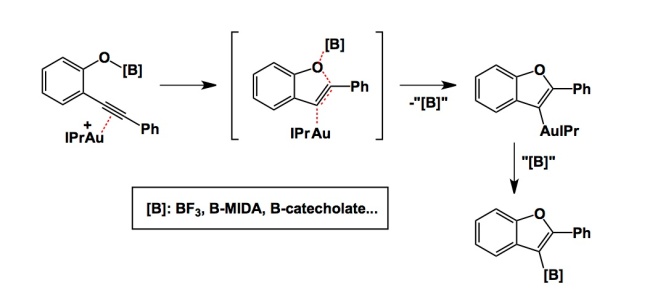I enjoyed reading Suzanne Blum’s full paper on intramolecular alkoxyboration of alkynes in JACS. The reaction is quite remarkable and amounts to addition of B-O bonds to alkynes under gold catalysis. The authors quote the fact that B-O bond is significantly stronger than B-C bond, which is one of the reasons why there have been comparative lack of success in the area B-O bond activation. I am showing a brief part of the overall process reported by Blum (the [B] fragment undergoes trifluoroacetate-assisted departure and is reincarnated as the electrophile in the next step): 
http://pubs.acs.org/doi/abs/10.1021/ja500463p
Au(I) turned out to be the optimal catalyst which, in its typical “alkynophilic” fashion, renders the triple bond susceptible to the attack by the nucleophilic phenoxide oxygen. It is at this point that boron electrophile is generated, which is the most intriguing part of the paper. Due to my lab’s recent interest in the effect of MIDA group on boron transfer reactions, the nature of boron electrophile here certainly piqued my interest. At this point, it is a bit difficult for me to envision B[MIDA] trifluoroacetate (that would be an analog of compound 16) as an effective electrophile. There are some thought-provoking lessons here, in my view.
